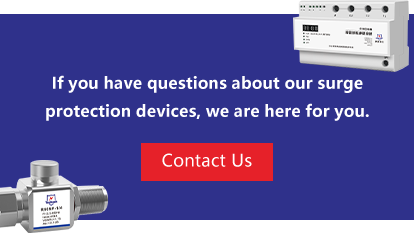As networks become increasingly complex and interconnected, the need for effective surge protection is paramount. Coaxial surge protection devices play a crucial role in safeguarding sensitive network equipment from transient voltage spikes. This passage offers guidance on selecting the right coaxial surge protection device for your network, emphasizing key considerations to ensure optimal protection.
Before selecting a coaxial lightning surge protector, it's crucial to understand the specific vulnerabilities and risks that your network faces. Identify potential sources of surges, such as lightning strikes, power grid fluctuations, or nearby electrical equipment. A thorough risk assessment provides a foundation for choosing surge protection solutions tailored to the unique challenges your network may encounter.
Different network components have varying levels of sensitivity to electrical surges. Assess the criticality of equipment within your network and determine the potential impact of a surge-induced failure. This analysis guides the selection of coaxial surge protection devices with appropriate voltage clamping levels and response times to effectively shield sensitive equipment.
The topology and architecture of your network play a significant role in determining the types of surge protection devices needed. For coaxial cables used in data transmission, such as those in cable TV or satellite systems, choose surge protection devices specifically designed for these applications. Consider whether the network operates in a point-to-point, daisy-chain, or mesh topology, as this influences the distribution and placement of surge protection devices.
Evaluate any existing surge protection measures within your network, such as at the power entry point or individual equipment. Ensure that the selected coaxial surge protection devices complement these measures to provide comprehensive and coordinated protection. A well-integrated approach enhances the overall resilience of the network.
Examine the technical specifications of coaxial surge protection devices, paying particular attention to their voltage ratings and clamping levels. The voltage rating should match the operating voltage of the network, while the clamping level determines how quickly the device responds to surges. Opt for devices with lower clamping levels for faster response times and enhanced protection.
Ensure that the selected coaxial surge protection devices comply with relevant industry standards and regulations. Compliance certifications validate the performance and reliability of the devices. Look for certifications from recognized organizations, such as UL (Underwriters Laboratories) or IEEE (Institute of Electrical and Electronics Engineers), to guarantee the quality and effectiveness of the surge protection solution.
Selecting the right coaxial surge protection device involves a meticulous evaluation of your network's vulnerabilities, topology, and technical requirements. By understanding potential surge sources, matching protection to network architecture, and considering technical specifications and compliance, you can tailor the surge protection solution to meet the specific needs of your network. Investing in the right coaxial surge protection devices not only safeguards sensitive equipment but also contributes to the overall reliability and resilience of your network in the face of electrical disturbances.
 How to Wire a Three-phase Surge Protector?September 22, 20221. Wiring method of three-phase surge protectorIn the TN system, in general, the surge protector only needs to be connected in common mode, that is, connected between the neutral line of the phase lin...view
How to Wire a Three-phase Surge Protector?September 22, 20221. Wiring method of three-phase surge protectorIn the TN system, in general, the surge protector only needs to be connected in common mode, that is, connected between the neutral line of the phase lin...view How is a Surge Protector Grounded?February 1, 2023As we all know, the impact and damage of thunderstorms and lightning on us is very huge, so it is also very important to take corresponding lightning protection measures for various power supply elect...view
How is a Surge Protector Grounded?February 1, 2023As we all know, the impact and damage of thunderstorms and lightning on us is very huge, so it is also very important to take corresponding lightning protection measures for various power supply elect...view What Are the Commonly Used Lightning Protection Components?March 13, 2023External lightning protection system, consisting of lightning rods (or lightning conductors), down conductors, and grounding system, is mainly designed to protect buildings from lightning strikes whic...view
What Are the Commonly Used Lightning Protection Components?March 13, 2023External lightning protection system, consisting of lightning rods (or lightning conductors), down conductors, and grounding system, is mainly designed to protect buildings from lightning strikes whic...view Do every inverter has a surge protector? Where to install the surge protector in the PV system?June 5, 2025Inverter is indispensable in a PV system. But not every inverter is equipped with a surge protector. Some newer and more advanced inverter models have built-in surge protection as a standard feature, ...view
Do every inverter has a surge protector? Where to install the surge protector in the PV system?June 5, 2025Inverter is indispensable in a PV system. But not every inverter is equipped with a surge protector. Some newer and more advanced inverter models have built-in surge protection as a standard feature, ...view Use, Installation and Configuration of Surge ProtectorsMay 20, 20221. Parameters selected by SPD of surge protector at all level1. SPD-1If the first-level surge protector SPD1 is installed in the general power distribution room of a building, three switch-type surge ...view
Use, Installation and Configuration of Surge ProtectorsMay 20, 20221. Parameters selected by SPD of surge protector at all level1. SPD-1If the first-level surge protector SPD1 is installed in the general power distribution room of a building, three switch-type surge ...view Surge Protector for Closed-Circuit Television SystemJune 26, 2024This article will introduce the importance and working principle of surge protector for CCTV that meet the high availability requirements of closed-circuit television systems.The Necessity of Surge Pr...view
Surge Protector for Closed-Circuit Television SystemJune 26, 2024This article will introduce the importance and working principle of surge protector for CCTV that meet the high availability requirements of closed-circuit television systems.The Necessity of Surge Pr...view